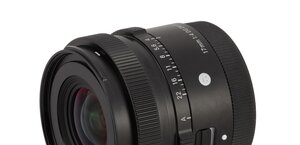Canon EF 200 mm f/2.0L IS USM
3. Build quality and image stabilization
Despite its significant dimensions the Canon 2.0/200 IS is still a lens which you can wear round your neck along with a body and take for a stroll outside without a tripod or monopod. After attaching a hood it becomes far less handy though.
In the photo below the tested lens is positioned between the Canon EF 70-300 mm f/4.0-5.6 IS USM and the Sigma 30 mm f/1.4 EX HSM.
Please Support UsIf you enjoy our reviews and articles, and you want us to continue our work please, support our website by donating through PayPal. The funds are going to be used for paying our editorial team, renting servers, and equipping our testing studio; only that way we will be able to continue providing you interesting content for free. |
- - - - - - - - - - - - - - - - - - - - - - - - - - - - - - - - - - - - - - - - - - - - - - - -
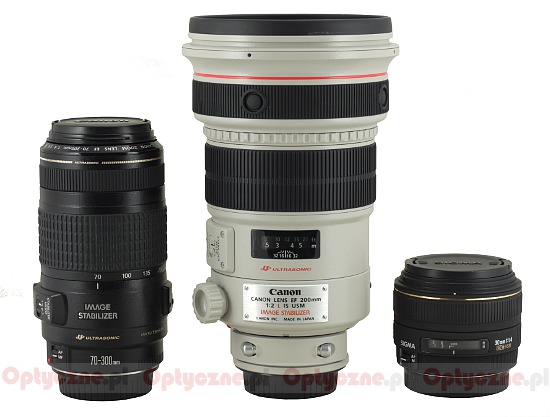 |
The lens starts with a metal mount with contacts. When you peek inside the mount you find there the first optical element, positioned about 17 mm deep – a removable filter with a diameter of 52 mm, added to the device in the box. When you get the filter out the first proper element of the lens is situated about three centimeters inside the barrel. It is immobile and the area next to it – black and matted very efficiently.
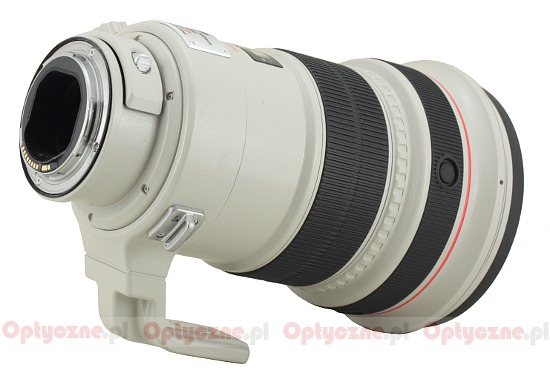 |
Moving to the proper casing of the lens you can find its first part which is similar to the Canon 1.4x converter (only a bit smaller). On the top there is a mount filter thread with a diameter of 52 mm and on the left – the focusing mechanism switch (AF- autofocus, MF- manual focus) and also a focus limiter (with two ranges: from 1.9 meters to infinity and from 3.5 meters to infinity).
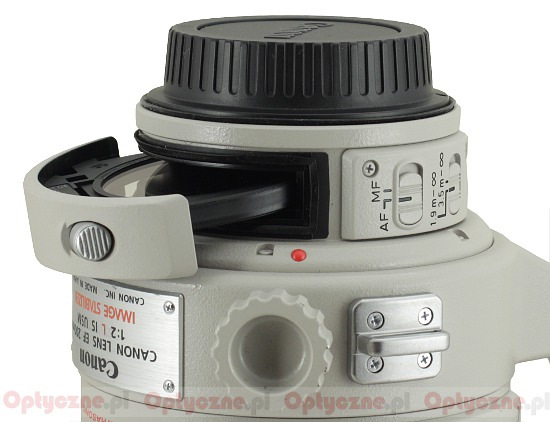 |
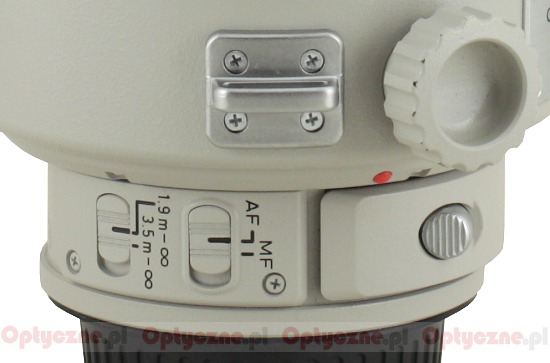 |
The next part of the body is much wider and includes a very solid and huge ring which turns into an equally solid tripod adapter. On the ring there is a plate with the name and parameters of the lens, a loosening screw and metal holders to which you can attach a strap. Further on, in the direction of the front element, you can find a distance scale behind a window, expressed in meters and feet. It also includes a depth of field scale markings at f/16 and f/32. On its left side there is a next series of switches. The first one allows you to choose an optical stabilization mode (Mode 1 and 2). The second switch let you choose the right optical stabilization mode (STABILIZER ON/OFF). Then there is a round SET button and under it a FOCUS PRESET switch which has three positions (OFF, ON, sound signal). The FOCUS PRESET buttons are used to remember a chosen focusing mechanism position and bring it back when needed.
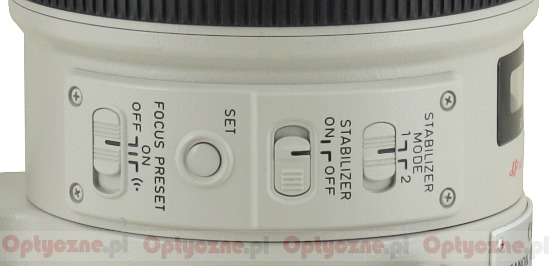 |
The next visible element is a big manual focus ring. It is as wide as 39 mm and padded with rubber ribs. Running through the whole scale needs a turn through about 210 degrees. Right behind it there is another ring which is white and much narrower, also ribbed but not rubber-padded (a so-called Playback ring). It is used to set the focus manually in the PF (Power focus) mode while e.g. you record a video to ensure a smooth and fluent focus change. The next ring has rubber ribs for a change but it is immobile and has four buttons to block the autofocus (so-called AF Stop Buttons) every 90 degrees. The next element of the casing includes a red stripe, so characteristic for the L series and a hood thread.
In front you can find a front element, about 10 cm in diameter, which doesn’t move and it hides less than 2.5 cm inside.
When it comes to the optical construction you deal here with 17 elements positioned in 12 groups. The Canon company boasts of using two low dispersion elements made of UD glass and one fluorite one as well. Inside, you can also find a circular aperture with nine diaphragm blades which can be closed to f/32.
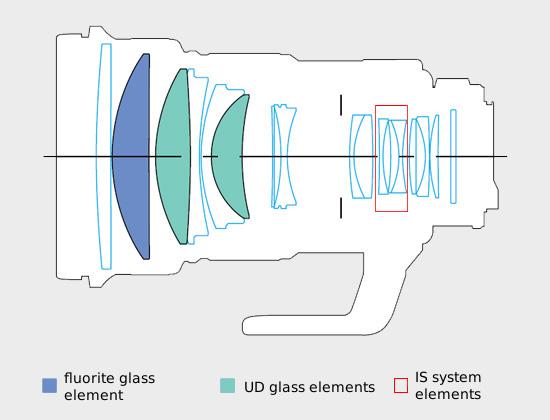
It’s worth noticing that the Canon 2/200 is a much more complicated instrument than the Canon 2.8/300. Small wonder – both these lenses have the front element of similar size (and their entrance pupils are alike as well) and, when it comes to optical aberrations, correcting a lens with a shorter focal length is more difficult. As a result the 2/200 model is more problematic to produce but still it remains cheaper. It is a fine example that the difficulty in producing a lens is not the only factor which influence its price and companies selling devices with longer focal lengths like fleecing their customers.
Buyers get in the box a huge hood which, inverted and joined with a kind of „hat” made of cloth, can be used as a front cap. Apart from that there is a build-in tripod adapter and a high quality Canon 200B carrying case, designed especially for this lens.
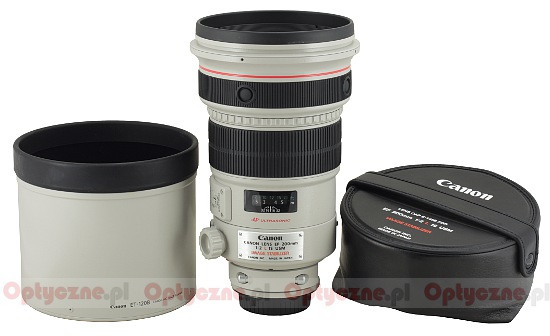 |
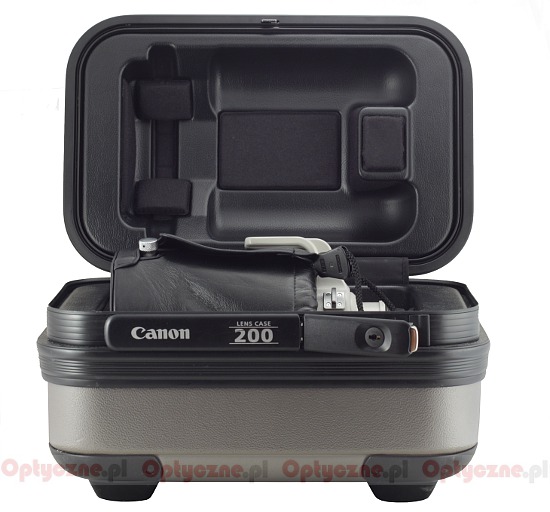 |
Stabilization
Currently almost every producer of optical lenses boasts of stabilization which can reach 4 EV. The problem is that only the best and the most expensive devices on the market really have such an efficient stabilization system; in case of most of other lenses its efficiency can be 2-3 EV at most.
You can see how the tested Canon EF 200 mm f/2.0L IS USM fares consulting a graph below.
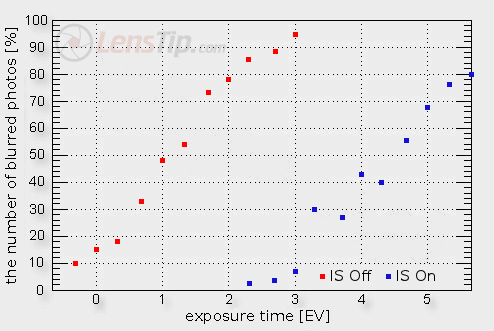
As you see our lens got close to 4 EV but didn’t reach that value. Its stabilization we assess as about 3.5 EV. Still, the 4EV level or higher is reserved only for the best devices produced after 2010. The Canon EF 200 mm f/2.0L IS USM, launched in 2008, can’t perform as well but 3.5 EV is still a very good level so the tested lens should be praised here.





